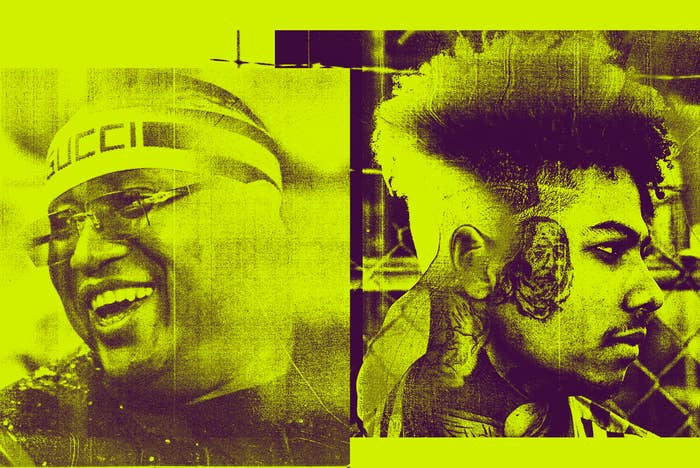
No matter how you slice it, rap is a mechanism comprised of three parts. There’s the beat, the rhyme, and the ability to apply one to the other. But that’s where any generalized description of the artform ends. Rap is constantly evolving, and numerous styles have come and gone since the genre’s inception from Bronx block parties in the ‘70s. Thanks to the viral rap phenomenon Blueface, there’s currently an obsession with a particular style—rapping offbeat, on purpose. There’s no doubt that he’s responsible for bringing this style to the forefront of the contemporary rap conversation, but whatever Twitter might have you thinking, rapping offbeat as a stylistic choice is far from new.
Blueface is the 21-year-old rapper out of Los Angeles that you keep hearing about. He’s been rapping for little more than a year, having picked up the craft thanks to coincidence; a rapper friend of his left something important in Blueface’s car one night, so the viral phenomenon went and dropped it off at the studio and decided to step into the recording booth. He released two mixtapes—Famous Cryp and Too Coccy—in 2018. Songs like “Deadlocs,” “Next Big Thing,” and “Thotiana” put a spotlight on the rapper’s ability to captivate with his unique style, but it wasn’t until he released the video for “Respect My Crypn” that the world really started paying attention.
After letting the beat build for exactly forty seconds, Blueface raps one of the most anxiety-inducing verses ever, continuously missing the down-thump of the beat while gushing one punchline after another. Ten years ago, this would have been the perfect parody video on MySpace. But there’s a seriousness to Blueface’s delivery. It feels not only authentic, but personal. As Blueface has been co-signed by artists like Drake and Quavo in the wake of his viral single, the discourse continues to shift away from the perceived quality of his work to its originality.
In truth, rapping offbeat isn’t anything new. Goonew, a rapper out of Maryland, predates the oldest Blueface record. Cash Kidd, out of Detroit, stretches back even farther. Then you have E-40, Suga Free, MF DOOM — pretty soon the list stretches back farther than can be counted on both hands. “Respect My Crypn” producer Laudiano believes that there shouldn’t be discussion about where or when the flow comes from, but how it’s used. “If anyone else tried it, it wouldn’t sound as natural, and that’s what makes his style so special,” Laudiano says of Blueface. He calls it “a take on the classic L.A. flow with a twist.”
Another young, rising artist experimenting with an offbeat flow is Goonew, a 21-year-old rapper from Maryland who began rapping in 2017 and has received cosigns from both G Herbo and Lil Yachty. His dark trap music, delivered with a whisper, is offbeat. “I started rapping offbeat on purpose,” he says. “I can do it on and off. I control it because it is done intentionally.” Listen to the chorus of “Stain” or his breakout single “Down Bad” to hear the slight gap between the 808 and his voice. When the discussion picked up in the fervor surrounding Blueface, Goonew’s name was generally missing. On Twitter, fanshave voiced their own beliefs that there are some similarities between Goonew and Blueface’s flow, but Goonew lets them talk. “I don’t think I’m one of his influences and even if I was I would be surprised,” he says. “The styles are similar but his has a west coast twist on it.”
In Detroit, one of the most popular YouTube channels is 4ShoMagazine, a Worldstar-like collection of rising music videos and interviews, curated by rapper Coach Joey, that exclusively posts artists from the city. Tee Grizzley’s success with “First Day Out” came from the video being posted to the channel and going viral, something the rapper frequently talks about in interviews. Aside from Tee Grizzley, some of the most popular videos on the channel come from Cash Kidd. The 27-year-old rapper is perhaps the most offbeat of them all, but he doesn’t necessarily classify it as that.
“I came up with this style—no style really—just from growing up here. It’s in the city,” he says. His breakout hit “On My Mama” in 2014 precedes the oldest Goonew and definitely the oldest Blueface songs. Cash Kidd’s since zeroed in on the flow and both recognizes and acknowledges Blueface’s popularity with the style. “There might not be any influence there, but Detroit and California are very close,” he says.
An infamous quote from author Mark Twain’s autobiography reads, “There is no such thing as a new idea. It is impossible. We simply take a lot of old ideas and put them into a sort of mental kaleidoscope.” This, especially, applies here. Veteran rappers have been skipping beats for years. E-40 explains over the phone that when he first started thirty years ago he hadn’t heard anyone prior to him rapping in the style that he refers to as “different patterns, start stop and go, and 0 to 160 real quick.” He adds, “It’s a new way to do it now, and then there’s how I do it. The flow is important, but at the end of the day it’s about what you say and how it comes across.”
As far as E-40’s concerned, before him, there was no offbeat flow. Hip-hop historians typically agree that the popularization of the style comes from one of two sources: E-40 or Suga Free. “I’ve been doing it for thirty years,” E-40 says. “Before me, there was no offbeat flow. Suga Free is my guy he grew up on me and he mastered the craft, the style. We OGs in it and we made sure to spit some game.”
Just as hip-hop heads compare the styles of E-40 and Suga Free, they now seek to connect him with Blueface. “He’s a cool youngster. We met through the mutual friends,” E-40 says of the viral star. “My boy James TooCold—I signed him and they were already tapped in. They did a song together, ‘No Witness,’ and I hit him up afterwards.” Instead of taking a confrontational approach to a younger generation, E-40 seeks to embrace rap’s new wave. “I’m putting together a record for my album right now with Blueface,” he says.
Both Goonew and Cash Kidd say that their takes on the style didn’t come from artists before them, though. “I think I’m one of the 'OGs' of the offbeat flow,” Goonew says, believing that his style is different than what these older emcees pushed. “It made me stand out from the typical trap flow, the hypeness from the Meek Mill types. I used to be criticized a lot for being offbeat and now I’m influencing the industry. I just want the recognition for it.” E-40, in contrast, can do without the public acknowledgment. “Wherever it counts at, the hood, the soil, the sludge, the thick of the slums, as long as they know, I’m good. I don’t need the suburbs to verify a dude that’s from the streets.”
There is always a new generation of listeners coming along, so there is always something from the past that can be presented as a ‘new’ thing. - Paul Edwards
Paul Edwards is an author of three analytical hip-hop books including How to Rap and The Concise Guide to Hip-Hop Music. Having interviewed over 100 rappers like Pharoahe Monch and Tech N9ne, he recognizes that there’s some originality in the approach of newer artists, even if MCs from rap’s earliest times were the true inventors of the flow. “I think a lot of these things are cyclical,” he says. “There is always a new generation of listeners coming along, so there is always something from the past that can be presented as a ‘new’ thing. Most people today probably haven’t gone back and listened to someone like Kool Keith who was doing this kind of thing in 1988, so it’ll seem fresher to them.”
Edwards digs even further back, adding, “This has been present in music for a long time, if you think of things like Isaac Hayes' 'Ike's Rap' series of records, or records by The Last Poets, or essentially any spoken-word poetry records,” he says. “This newer offbeat style of rap is somewhere towards the more ‘talking’ end of the spectrum."
Even with its true roots tracing back some thirty years, the novelty of the the offbeat flow aesthetic has reaped huge rewards for the three previously mentioned lyricists. Blueface signed a record deal with Cash Money West, Cash Kidd has become one of the most popular artists on Detroit’s 4746 Global record label, and it’s only a matter of time before Goonew’s scooped up after appearing on Red Bull Radio and being covered by Noisey, The Fader, and Mass Appeal.
They don’t want anyone to go outside of their box, jurisdiction, or envelope. I went out of mine years ago and that made me an innovator. - E-40
The discourse may suggest that offbeat rapping is a nuisance, but the numbers and attention suggest otherwise. How long it lasts as a major topic in rap circles is anyone’s guess. “I think, like most things, it'll have its day and then be replaced with something that is often the opposite of it,” Edwards says. “A structured, highly technical style seems more exciting if you've just had a period of simpler, offbeat styles. And then, the simpler style seems refreshing if everyone has been sticking rigidly to a structure.”
One side effect of the current conversation around the offbeat flow is that it has exposed the culture’s love-hate relationship with innovation. E-40 withstood the test of time by constantly innovating, and, in the process, become one of rap’s elite. Blueface, Goonew, and Cash Kidd, on the other hand, receive equal amounts of hate as they do praise. The culture will reward them for trying something new later, but right now the discussion indicates that their creativity isn’t truly valued. E-40 dealt with a similar problem in the 1990s when he received flak for his style. “They don’t want anyone to go outside of their box, jurisdiction, or envelope,” he says. “I went out of mine years ago and that made me an innovator.” This creativity, and willingness to go against the grain, is what keeps hip-hop alive and fresh across generations. The offbeat flow’s beginning and end may not be concrete, but its cyclical nature is.

